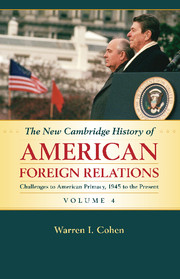7. The Rise and Fall of Détente
The single most valuable book for the Nixon, Ford, and Carter years is
Raymond L. Garthoff, Détente and Confrontation (Washington, D.C., 1985). Although ruthless editing might have produced a better book at half the length, it is a gold mine of information provided by a thoughtful midlevel participant.
Henry Kissinger’s two-volume memoir, The White House Years (Boston, 1979) and
Years of Upheaval (Boston, 1982), is self-serving but nonetheless essential reading.
Walter Isaacson, Kissinger (New York, 1992), provides a reasonable corrective.
William Hyland, Mortal Rivals: Superpower Relations from Nixon to Reagan (New York, 1987), is a useful study by another midlevel participant.
The complex character of Richard M. Nixon is deciphered only in
Garry Wills, Nixon Agonistes (Boston, 1970). Good critical accounts of the Nixon-Kissinger years are provided by the journalists
Tad Szulc, The Illusion of Peace (New York, 1979), and
Seymour Hersh, The Price of Power (New York, 1983), the latter probably a trifle severe for the taste of most readers.
Zbigniew Brzezinski, Power and Principle (New York, 1983), is informative, especially of the author’s efforts as national security adviser to usurp power once reserved for the secretary of state. For ego, the memoir rivals Kissinger’s – but lacks the self-deprecating wit that was always Henry’s charm. Instead of Carter’s memoir, look to
Gaddis Smith, Morality, Reason and Power (New York, 1986), for an understanding of Carter’s foreign policy efforts.
Cyrus Vance tells his own story in Hard Choices (New York, 1983).
Given the limited documentation available, Soviet-American relations are covered surprisingly well.
Robert S. Litwak, Détente and the Nixon Doctrine (Cambridge, 1984), neatly indicates the contrasting expectations each side had of détente.
Joseph S. Nye, Jr., The Making of America’s Soviet Policy (New Haven, 1984), contains several useful essays.
Harry Gelman, The Brezhnev Politburo and the Decline of Détente (Ithaca, 1984), is vintage Kremlinology. The Soviet thrust in the Third World characteristic of the late 1970s is analyzed nicely in
Rajan Menon, Soviet Power and the Third World (New Haven, 1986), and
Jerry Hough, The Struggle for the Third World (Washington, D.C., 1986).
David Holloway, The Soviet Union and the Arms Race, 2d ed. (New Haven, 1984), focuses on the other critical issue in Soviet-American relations in the 1970s.
Melvyn P. Leffler, For the Soul of Mankind: The United States, the Soviet Union, and the Cold War (New York, 2007), and Zubock, Failed Empire, are especially good on the Brezhnev years.
For Sino-American relations, see
Harry Harding, A Fragile Relationship: The United States and China Since 1972 (Washington, D.C., 1992).
John W. Garver, China’s Decision for Rapprochement with the United States, 1968–1971 (Boulder, Colo., 1982), is interesting and suggestive.
Nancy Bernkopf Tucker, Strait Talk: United States-Taiwan Relations and the Crisis with China (Cambridge, Mass., 2009), provides the definitive analysis of the Taiwan issue. See also
Michel Oksenberg, “A Decade of Sino-American Relations,” Foreign Affairs 61 (1982): 175–95. The Chinese perspective is offered in
David Shambaugh’s fascinating analysis of the views of China’s foreign policy elite, Beautiful Imperialist (Princeton, 1991). See also Chen
Jian’s Mao’s China and the Cold War (Chapel Hill, 2001).
William B. Quandt, Decade of Decisions: American Policy Toward the Arab-Israeli Conflict, 1967–1976 (Berkeley, 1977), and
Gary Sick, All Fall Down (New York, 1985), are excellent on Arab-Israeli relations and the collapse of the American position in Iran, respectively. On Iran, see also
James A. Bill, The Eagle and the Lion (New Haven, 1988). Oksenberg, Quandt, and Sick all served on the National Security Council. For economic issues, especially the collapse of the Bretton Woods system,
Joanne Gowa, Closing the Gold Window: Domestic Politics and the End of Bretton Woods (Ithaca, 1983), and
Robert Gilpin, The Political Economy of International Relations (Princeton, 1987), are most helpful.



